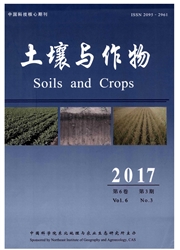

 中文摘要:
中文摘要:
东北黑土区是我国第二大粮食主产区,由降水变异较大引起的季节性干旱是限制粮食产量的主要因素。但是我们缺乏对该地区土壤水分缺乏时间的研究。研究以中国科学院海伦农田生态系统国家野外科学观测研究站内1999年-2008年的水分数据和气象数据为基础,结合Penman—Monteith公式计算得到的潜在蒸散量,通过分析作物根系活动内土壤储水量与潜在蒸散量之间的关系得到,在整个生长季内并不存在土壤水分缺乏,然而水分缺乏时期主要发生在每年的6月份和7月份,平均缺乏量分别为2.43mm和7.04mm,发生的概率分别为90%以上和50%以上。土壤水分缺乏主要受作物生长季内降水分布的影响。同时不同施肥管理对土壤水分缺乏的影响表现为化肥与有机肥的配合施用增加土壤水分缺乏发生的概率,化肥的施用次之,无肥的影响最小。因此,在研究区域肥料的施用已经引起了土壤的水分缺乏,关于土壤水分缺乏对粮食产量影响是需要我们再进一步研究的。图5,表3,参18。
 英文摘要:
英文摘要:
The black soil region in Northeast China is the second largest granary of China. The seasonal drought caused by the uneven distribution of annual precipitation threatens the crop yield in this region. However,information about when water deficit could happen is limited. Based on observed soil water data and climate data from the National Field Research Station of Agro-ecosystem in the Chinese Academy of Sciences from 1999 to 2008, combined potential evapotranspiration calculated from Penman-Monteith euquation, soil water deficit was obtained from the difference between soil water content in root activity zone and potential evapotranspiration. No water deficit was observed in whole growing seasons,but water deficit period was found in June and July with water deficit amount of 2. 34 mm and 7.04 mm, which was over 90% and 50% probability of water deficit occurrence respectively. The main factors impacting soil water deficit were the distribution of rainfall and fertilization practices. The effect of different fertilization practices on soil water deficit showed an increasing order of no fertilizer 〈 chemical fertilizer 〈 chemical fertilizer plus organic manure. Therefore, the application of fertilization resulted in soil water deficit in the study site, and it is essential to pay more attention to the effect of water deficit on crop yield.
 同期刊论文项目
同期刊论文项目
 同项目期刊论文
同项目期刊论文
 The effect of long-term fertilization on soil water dynamics, crop yield and WUE in a field experime
The effect of long-term fertilization on soil water dynamics, crop yield and WUE in a field experime 期刊信息
期刊信息
